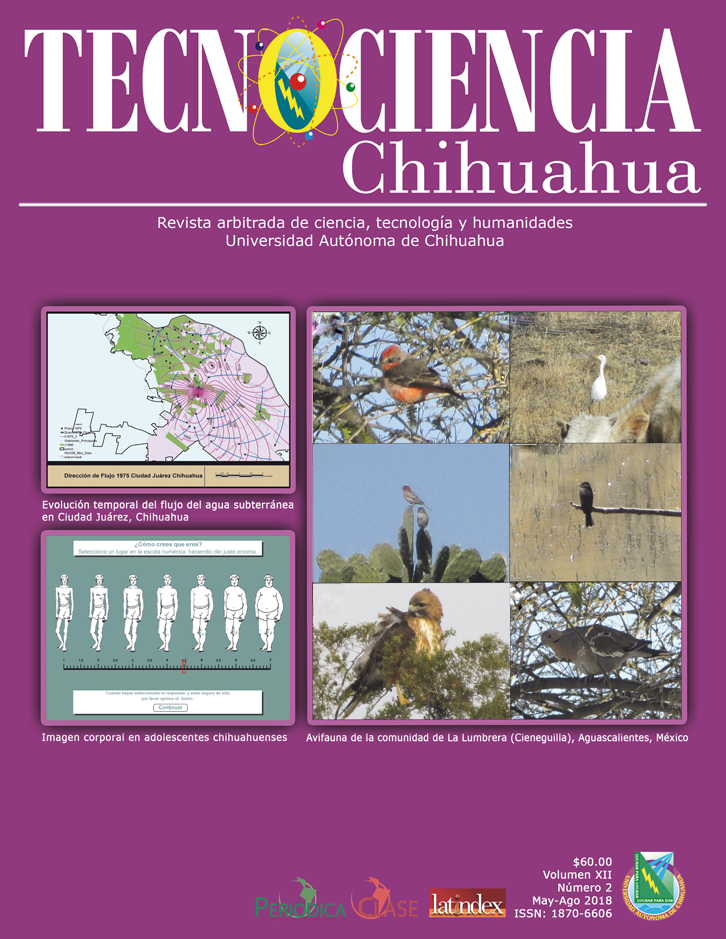Las estructuras de familia en Chihuahua en 2015: organización y dinámicas de cambio
Family structures in Chihuahua in 2015: Organization and dynamics of change
Resumen
La Encuesta Intercensal 2015, levantada por el Instituto Nacional de Estadística e Informática, INEGI, nos permite estudiar de mejor manera las estructuras de familia en el estado de Chihuahua, México. Para tal fin, partimos de un enfoque multidimensional de dichas estructuras que considera las dinámicas de autoridad, el marco normativo de derechos y obligaciones, los vínculos de parentalidad, los procesos de estabilidad o transición, así como los sistemas básicos y complementarios de relaciones sociales. Al aplicar esta perspectiva a Chihuahua, lo que se encontró fueron cuatro tipos principales de hogares familiares según estén encabezadas por parejas casadas, parejas en unión libre, jefas solas y jefes solos, divididos en 22 subtipos diferentes. En conjunto abarcan 84.5 % de los hogares de la entidad federativa, a lo que debemos sumar un 12.4 % de hogares de personas solas, además de otro grupo pequeño conformado por cuatro tipos de hogar diferentes (3.1 % en conjunto). También se hace un análisis comparativo respecto de los resultados de los Censos de Población y Vivienda de 2000 y 2010.
Citas
Acs, G. 2007. Can We Promote Child Well-Being by Promoting Marriage? Journal of Marriage and Family 69(5): 1326-1344. https://doi.org/10.1111/j.1741-3737.2007.00450.x
Amador, D. & R. Bernal. 2012. ¿Unión libre o matrimonio? Efectos en el bienestar de los hijos. Fondo de Cultura Económica. El Trimestre Económico 79(315): 529-573. https://www.eltrimestreeconomico.com.mx/index.php/te/article/view/69
Arránz, O., V. Salzburger, N. Lois & B. Nauck. 2013. What narrows the stepgap? Closeness between parents and adult (step) children in Germany. Journal of Marriage and Family 75(5): 1130-1148. https://doi.org/10.1111/jomf.12052
Ayllón, S. & N. N. Ferreira-Batista. 2015. ‘Mommy, I miss daddy’. The effect of family structure on children’s health in Brazil. Economics and Human Biology 19: 75-89. https://doi.org/10.1016/j.ehb.2015.08.001
Castro, R. & I. Casique. 2008. Violencia de género en las parejas mexicanas. Análisis de resultados de la Encuesta Nacional sobre la Dinámica de las Relaciones en los Hogares 2006. Primera Edición. Instituto Nacional de las Mujeres. http://cedoc.inmujeres.gob.mx/documentos_download/100925.pdf
Dawkins, P., P. Gregg & R. Scutella. 2002. The growth of jobless households in Australia. The Australian Economic Review 35(2): 133-154. https://doi.org/10.1111/1467-8462.00231
Degraff, D. S. & D. Levison. 2009. Children’s work and mothers’ work––What is the connection? World Development 37(9): 1569-1587. https://doi.org/10.1016/j.worlddev.2009.01.006
Duarte-Jáquez, C. H. 2012. 2º Informe de Gobierno. Resumen ejecutivo. Chihuahua: Secretaría de la Función Pública.
Duarte-Jáquez, C. H. 2013. 3º Informe de Gobierno. Resumen ejecutivo. Chihuahua: Secretaría de la Función Pública.
Duarte-Jáquez, C. H. 2014. 4º Informe de Gobierno. Resumen ejecutivo. Chihuahua: Secretaría de la Función Pública.
Duarte-Jáquez, C. H. 2015. 5º Informe de Gobierno. Resumen ejecutivo. Chihuahua: Secretaría de la Función Pública.
Dykstra, P. A. & R. Keizer. 2009. The wellbeing of childless men and fathers in Mid-life. Ageing & Society 29(8): 1227-1242. http://doi.org/10.1017/S0144686X08008374
Feijten, P. & C. H. Mulder. 2010. Gender, divorce and housing - A life course perspective. Wohnen und gender. En Wohnen und Gender: theoretische, politische, soziale und räumliche Aspekte: gewidmet Ruth Becker (pp. 175-193). VS Verlag für Sozialwissenschaften. ISBN 9783531159102. https://hdl.handle.net/11245/1.311487
Hansen, T., T. Moum & A. Shapiro. 2007. Relational and individual well-being among cohabitors and married individuals in midlife. Recent trends from Norway. Journal of Family Issues 28(7): 910-933. https://doi.org/10.1177/0192513X07299610
Herrera, S., V. Salinas & E. Valenzuela. 2011. Familia, pobreza y bienestar en Chile: un análisis empírico de las relaciones entre estructura familiar y bienestar. Temas de la Agenda Pública 6(44): 1-19. https://repositorio.uc.cl/handle/11534/1770
Howe, L. D., S. R. A. Huttly & T. Abramsky. 2006. Risk factors for injuries in young children in four developing countries: The Young Lives Study. Tropical Medicine and International Health 11(10): 1557-1566. https://doi.org/10.1111/j.1365-3156.2006.01708.x
Instituto Nacional de Estadística y Geografía. 2010. Síntesis metodológica y conceptual del Censo de Población y Vivienda 2010. INEGI. https://www.inegi.org.mx/app/biblioteca/ficha.html?upc=702825002065
Instituto Nacional de Estadística y Geografía. 2015. Encuesta intercensal 2015: síntesis metodológica y conceptual. México: INEGI. https://www.inegi.org.mx/app/biblioteca/ficha.html?upc=702825078836
Kennedy, S. & C. A. Fitch. 2012. Measuring cohabitation and family structure in the United States: Assessing the impact of new data from the Current Population Survey. Demography 49(4): 1479-1498. https://doi.org/10.1007/s13524-012-0126-8
Kulu, H. & E. Washbrook. 2014. Residential context, migration and fertility in a modern urban society. Advances in Life Course Research 21: 168-182. https://doi.org/10.1016/j.alcr.2014.01.001
MacKenzie, M. B. & K. F. Fowler. 2013. Social anxiety disorder in the Canadian population: Exploring gender differences in sociodemographic profile. Journal of Anxiety Disorders 27(4): 427-434. https://doi.org/10.1016/j.janxdis.2013.05.006
Marks, G. N. 2006. Family size, family type and student achievement: Cross-national differences and the role of socioeconomic and school factors. Journal of Comparative Family Studies 37(1): 1-24. https://doi.org/10.3138/jcfs.37.1.1
Martin, N. & J. Vall. 2016. Effects of the great recession on drugs consumption in Spain. Economics and Human Biology 22: 103-116. https://doi.org/10.1016/j.ehb.2016.03.005
Morissette, R. & Y. Ostrovsky. 2007. Income instability of lone parents, Singles and two-parent families in Canada, 1984 to 2004. Analytical Studies Branch Research Paper Series. Ottawa: Statistics Canada. Minister of Industry. https://www150.statcan.gc.ca/n1/pub/11f0019m/11f0019m2007297-eng.htm
Poortman, A. R. and Voorpostel, M. 2009. Parental divorce and sibling relationships. A research note. Journal of Family Issues 30(1): 74-91. https://doi.org/10.1177/0192513X08322782
Pliego-Carrasco, F. 2012. Familias y bienestar en sociedades democráticas. Miguel Ángel Porrúa. ISBN 6074015309, 9786074015300.
Pliego-Carrasco, F. 2014. Las familias en México. Editorial Porrúa. ISBN 6070917502, 9786070917509.
Pliego-Carrasco, F. 2017. Estructuras de familia y bienestar de niños y adultos. El debate cultural del siglo XXI. Cámara de Senadores. LXIII Legislatura. http://biblioteca.diputados.gob.mx/janium/bv/lxiii/estrfam_bieninadu.pdf
Sedlak, A. J., J. Mettenburg, M. Basena, I. Petta, K. McPherson, A. Green & S. Li. 2010. Fourth National Incidence Study of Child Abuse and Neglect (NIS–4): Report to Congress. First Edition. Department of Health and Human Services. Administration for Children and Families. https://www.acf.hhs.gov/opre/report/fourth-national-incidence-study-child-abuse-and-neglect-nis-4-report-congress
Spiess, C. K. & K. Wrohlich. 2008. The parental leave benefit reform in Germany: Costs and labour market outcomes of moving towards the Nordic model. Population Research and Policy Review 27(5): 575-591. https://doi.org/10.1007/s11113-008-9086-5
Derechos de autor 2018 TECNOCIENCIA Chihuahua

Esta obra está bajo licencia internacional Creative Commons Reconocimiento-NoComercial 4.0.







